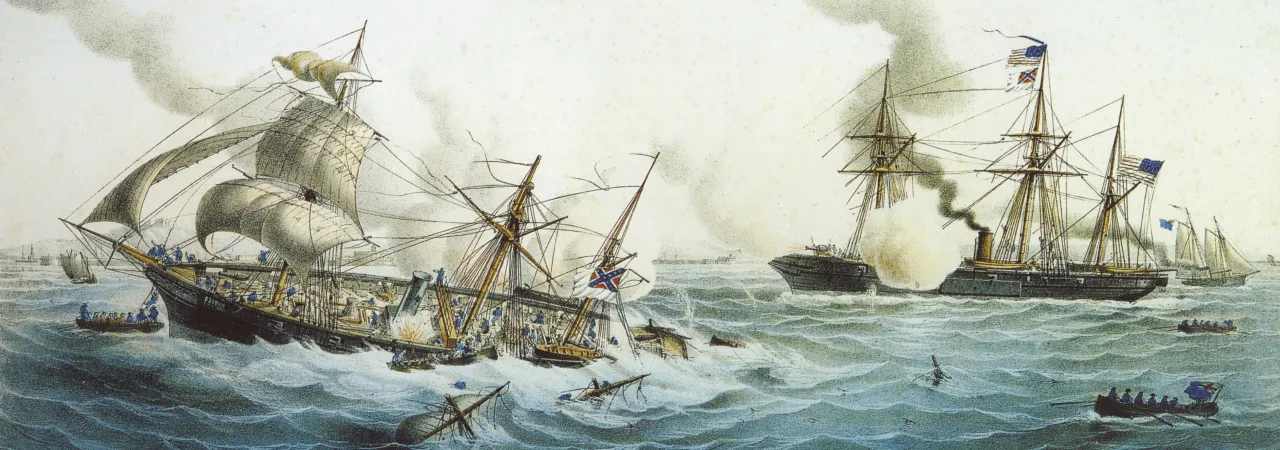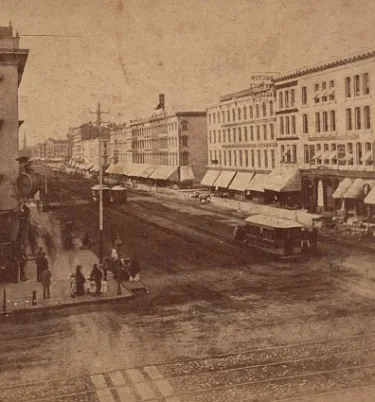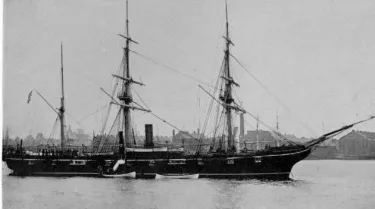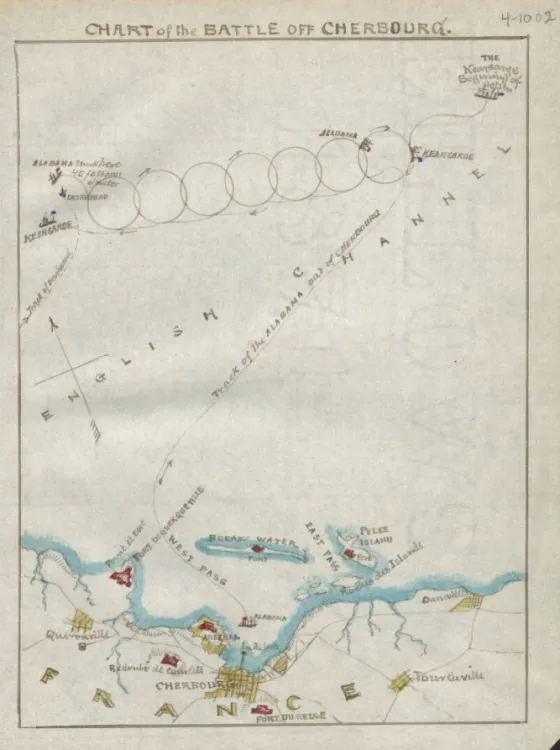
When the Civil War began, not all the Michigan men who answered their country’s call to duty found themselves in the Union armies. According to U. S. Navy records, 598 men who enlisted in the Navy were from Michigan. One of them was Ordinary Seaman William Gowin from Detroit, who joined the Navy in 1862 for a two-year enlistment.

William’s father, Claude Gowin (sometimes spelled Gouin or Gowen), was probably a Canadian citizen. He was a business associate of James Dougall, the mayor of the city of Windsor in Canada West (today’s province of Ontario). Windsor was directly across the Detroit River from Detroit where the Gowin family lived, and both cities were close economically. Claude owned a farm on the Canadian side of the St. Clair River in the township of Sombra, about 50 miles upriver from Windsor. Claude and his wife Margaret were married in Grosse Pointe, just outside of Detroit in 1819 and Margaret gave birth to William in 1834. They also had two daughters. Claude died in 1843 when William was nine, leaving the farm in Canada to his widow.
Like many boys his age in Michigan and Canada, young William “followed the lake” and became a sailor around age 17. Gowin’s father had left the family in “very limited circumstances,” so William worked to help pay the bills at home. He worked during the spring and summer months on ships that carried commerce up and down the Great Lakes and on boats that moved goods across the Detroit River. During the fall and winter seasons when the lakes and rivers froze, Gowin sold hay and chopped wood from his mother’s farm. He sometimes worked as a clerk in a store, whose owner H. A. Lacey noted Gowin was “sober, temperate and industrious, and not given to any bad habits.” Lacey sometimes paid young Gowin in groceries and other goods to provide for the family. In the spring, William would be back on the lakes working to support his mother and sisters. Gowin’s friend Samuel Jeffrey remembered that “William and I sailed together at intervals of three or four months at a time for three years,” often dropping off goods from their boat at the dock near the Gowin family farm. William made $100 for his family in 1861, the year before he enlisted in the Navy.
When the war came and the shipping season on the lakes ended, Gowin joined the Navy in Boston on January 1, 1862, giving his address as Detroit, Michigan. He was assigned to the brand-new, steam sloop-of-war USS Kearsarge. Soon, Gowin and the Kearsarge were crossing the Atlantic, hunting Confederate commerce raiders in European waters. When Gowin left home, he had promised his mother he would take care of her. Several months after embarking on the Kearsarge, Gowin sent a letter to his mother telling her he was saving up money to send or bring back to her, and that he “intended to make her comfortable.”

Familiar with living and working on a ship, Gowin seemed to find a new life in the Navy and he quickly developed a happy-go-lucky personality. His “jovial” behavior and musical skills led to his appointment as the ship’s unofficial clown and a key member of the “Kearsarge Minstrels” musical group. On one port visit to Cadiz, Spain, Gowin and two other sailors bought guitars, a cello, and an accordion. (Sadly, there is no record of which instrument Gowin played for the Minstrels). While visiting the Azores, Gowin and the Minstrels performed a benefit for the local poor. The Navy suited Gowin well: when his two-year enlistment was extended in January 1864, he received a 25% pay increase.
By all accounts, the “fun loving” Gowin was a typical sailor. He was once arrested for fighting and was briefly confined to the ship. During another liberty port call in Cadiz, Gowin stayed too long in a local cantina and missed the launch back to the Kearsarge, where he was punished the next morning for being absent without leave. After another night of drinking in Boulogne, France, Gowin and some other deckhands exhausted the patience of the ship’s master-at-arms, who clamped them in irons for “brawling and mutinous, belligerent cursing.” Although high seas combat eluded the Kearsarge for most of her cruise, life as a sailor was still dangerous work. One evening, when Kearsarge was taking on stores in the Azores, Gowin and another sailor were nearly drowned when a small supply boat they were on was swamped in rough seas.

On June 12, 1864, Kearsarge departed port in pursuit of the Confederate raider CSS Alabama. Kearsarge met Alabama off Cherbourg, France on June 19th and a fierce battle between the two ships ensued. Both ships engaged each other at close range. Kearsarge fired two massive 11-inch smoothbore pivot guns, one 30-pound Parrott rifle, and four 32-pound guns. Alabama responded with six 32-pounders, one 68-pounder, and a 100-pound Blakely rifle. One shell from the Alabama exploded near Kearsarge’s aft pivot gun, crewed by Gowin and other men. Gowin was severely injured by shell fragments; his left thigh and shin were both shattered with compound fractures. Gowin knew he was seriously wounded, but didn’t want the other men to leave their posts to help him. Surgeon John M. Browne of the Kearsarge wrote that “the hemorrhage was profuse… [Gowin’s] behavior during and after the battle were worthy of the highest praise. In agony, and exhausted from the loss of blood, he dragged himself from the aft pivot gun to the forward hatch [over 100 feet], concealing the severity of his injury, so that his comrades would not leave their stations for his assistance.” Captain John Winslow noted in his report of the battle that Gowin’s “cheerful willingness to sacrifice his life for victory's sake was expressed in terms that animated and encouraged others.” Taken below deck, Gowin told Surgeon Browne, “It’s all right; I am satisfied, we are whipping the Alabama,” adding, "I willingly will lose my leg or life if it is necessary." He never lost his sense of humor. When a wounded shipmate next to him complained, Gowin quieted the sailor, saying, “Am I not worse hurt than you?” When the gun crews above cheered at the effect of their fire on the Alabama, Gowin would wave his hand over his head and join in the shout.
The Kearsarge won her battle with the Alabama, sinking the Confederate ship after a brief but intense fight. Three other Kearsarge sailors were wounded. Browne did everything he could for Gowin, but it was decided to leave him with the French surgeons at the Hospital de la Marine in Cherbourg. "This man, so interesting by his courage and resignation," wrote the French surgeon-in-chief, “with uniform patience and cheerfulness, enlisted general sympathy; all anxiously desired his recovery.” In the hospital Gowin was calmly resigned to his fate, repeating, again and again, his willingness to die since his ship had won a victory.
The surgeons could do little for Gowin. As he lay dying, he remembered his promise to his mother. Just before the end, Gowin told a shipmate, Seaman Timothy Canty, that he “lamented in tears of bitter anguish his fate, as he could not live to take care of his mother and sister.” Gowin got a promise from Canty that he would visit Gowin’s family. In his dying moments, Gowin asked his friend for writing materials and gave him his mother’s address. After the war, Canty kept his promise and visited Gowin’s mother, telling her and his sister that he had intended to “buy them a nice home.”
Gowin died on June 27 in the hospital, eight days after the battle. He was buried in the Cherbourg Communal Cemetery, next to the fresh graves of three Confederate sailors who were killed on the Alabama. The day Gowin died, Captain Winslow and two other officers were in Paris at a victory banquet hosted by the French government. Winslow was handed a telegram announcing the death of Gowin. “His name was honorably mentioned, his behavior eulogized, and his memory drunk in silence” at the banquet. French officials contributed $130 to a fund for Gowin’s family, which Winslow gave to Surgeon Browne. Before Kearsarge returned home, Gowin’s shipmates collected their own fund to pay for a granite obelisk with a brass plate for his grave in France.
Despite his promises to his mother, Gowin had not sent much, if anything, back to his family. His sister Julia noted that “friends through charity” helped support their mother most of the time William was away. Margaret Gowin ultimately received an $8 per month pension as Gowin’s beneficiary. Surgeon Browne also sent her the money collected by Captain Winslow at the banquet in Paris.
Today, the jovial and fun-loving William Gowin rests in a grave in France, far from Canada, and far from the country he fought to preserve.
Further Reading
-
War on the Waters: The Union and Confederate Navies, 1861-1865 By: James M. McPherson
-
Iron Dawn: The Monitor, the Merrimack and the Civil War Sea Battle that Changed History By: Richard Snow
-
Lincoln and His Admirals By: Craig Symonds
-
The Civil War at Sea By: Craig Symonds






